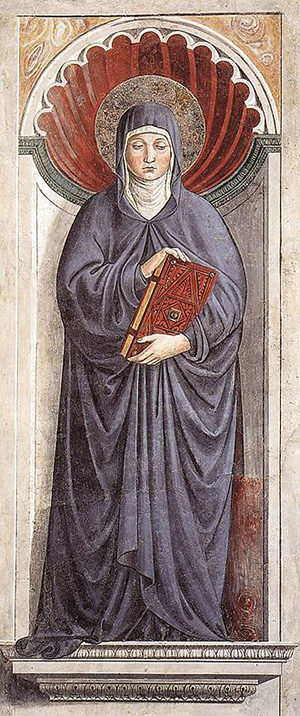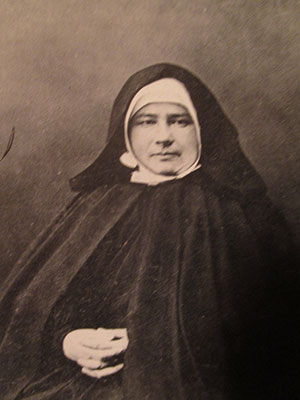 On Aug. 27, one day before the feast of her son St. Augustine, the Church honors St. Monica, whose holy example and fervent intercession led to one of the most dramatic conversions in Church history.
On Aug. 27, one day before the feast of her son St. Augustine, the Church honors St. Monica, whose holy example and fervent intercession led to one of the most dramatic conversions in Church history.
Monica was born into a Catholic family in 332, in the North African city of Tagaste (located in present-day Algeria). She was raised by a maidservant who taught her the virtues of obedience and temperance. While still relatively young, she married Patricius, a Roman civil servant with a bad temper and a disdain for his wife's religion.
Monica dealt patiently with his distressing behavior, which included infidelity to their marriage vows. But she experienced a greater grief when he would not allow their three children – Augustine, Nagivius and Perpetua – to be baptized. When Augustine, the oldest, became sick and was in danger of death, Patricius gave consent for his baptism, but withdrew it when he recovered.
Monica's long-suffering patience and prayers eventually helped Patricius to see the error of his ways, and he was baptized into the Church one year before his death in 371. Her oldest son, however, soon embraced a way of life that brought her further grief, as he fathered a child out of wedlock in 372. One year later, he began to practice the occult religion of Manichaeism.
In her distress and grief, Monica initially shunned her oldest son. However, she experienced a mysterious dream that strengthened her hope for Augustine's soul, in which a messenger assured her: "Your son is with you." After this experience, which took place around 377, she allowed him back into her home and continued to beg God for his conversion.
But that would not take place for another nine years. In the meantime, Monica sought the advice of local clergy, wondering what they might do to persuade her son away from the Manichean heresy. One bishop, who had once belonged to that sect himself, assured Monica that it was "impossible that the son of such tears should perish."
These tears and prayers intensified when Augustine, at 29, abandoned Monica without warning as she passed the night praying in a chapel. Without saying goodbye to his mother, Augustine boarded a ship bound for Rome. Yet even this painful event would serve God's greater purpose, as Augustine left to become a teacher in the place where he was destined to become a Catholic.
Under the influence of the bishop St. Ambrose of Milan, Augustine renounced the teaching of the Manichees around 384. Monica followed her son to Milan and drew encouragement from her son's growing interest in the saintly bishop's preaching. After three years of struggle against his own desires and perplexities, Augustine succumbed to God's grace and was baptized in 387.
Shortly before her death, Monica shared a profound mystical experience of God with Augustine, who chronicled the event in his "Confessions." Finally, she told him: "Son, for myself I have no longer any pleasure in anything in this life. Now that my hopes in this world are satisfied, I do not know what more I want here or why I am here."
"The only thing I ask of you both," she told Augustine and his brother Nagivius, "is that you make remembrance of me at the altar of the Lord wherever you are."
St. Monica died at age 56, in the year 387.
Augustine recounted her in his Confessions: "I will not speak of her gifts, but of Thy gift in her; for she neither made herself nor trained herself. Thou didst create her, and neither her father nor mother knew what kind of being was to come forth from them. And it was the rod of Thy Christ, the discipline of Thy only Son, that trained her in Thy fear, in the house of one of Thy faithful ones who was a sound member of Thy Church."
St. Monica is the patroness of abuse victims, alcoholics, difficult marriages, disappointing children, homemakers, married women, mothers, victims of adultery, victims of verbal abuse, widows and wives. She has also become the inspiration for the St. Monica Sodality, which encourages prayer and penance among Catholics whose children have left the faith.
Learn more
The St. Monica Sodality began at St. John Cantius Church of Chicago in 1995. The Sodality's purpose is to pray for a return to Catholic unity and provide prayerful support for those who have experienced the loss of faith of a loved one. For more, go online to www.cantius.org/go/organizations/category/st_monica_sodality.
–Benjamin Mann, Catholic News Agency
 On Aug. 30, the Church celebrates St. Jeanne Jugan, also known as Sister Mary of the Cross. During the 19th century, she founded the Little Sisters of the Poor with the goal of imitating Christ’s humility through service to elderly people in need.
On Aug. 30, the Church celebrates St. Jeanne Jugan, also known as Sister Mary of the Cross. During the 19th century, she founded the Little Sisters of the Poor with the goal of imitating Christ’s humility through service to elderly people in need.
In his homily for her canonization in October 2009, Pope Benedict XVI praised St. Jeanne as “a beacon to guide our societies” toward a renewed love for those in old age. The pope recalled how she “lived the mystery of love” in a way that remains “ever timely while so many elderly people are suffering from numerous forms of poverty and solitude and are sometimes also abandoned by their families.”
Born on Oct. 25, 1792, in a port city of the French region of Brittany, Jeanne Jugan grew up during the political and religious upheavals of the French Revolution. Four years after she was born, her father was lost at sea. Her mother struggled to provide for Jeanne and her three siblings, while also providing them secretly with religious instruction amid the anti-Catholic persecutions of the day.
Jeanne worked as a shepherdess, and later as a domestic servant. At age 18, and again six years later, she declined two marriage proposals from the same man. She told her mother that God had other plans, and was calling her to “a work which is not yet founded.”
At age 25, the young woman joined the Third Order of St. John Eudes, a religious association for laypersons founded during the 17th century. Jeanne worked as a nurse in the town of Saint-Servan for six years, but had to leave her position due to health troubles. Afterward she worked for 12 years as the servant of a fellow member of the third order, until the woman’s death in 1835.
During 1839, a year of economic hardship in Saint-Servan, Jeanne was sharing an apartment with an older woman and an orphaned young lady. It was during the winter of this year that Jeanne encountered Anne Chauvin, an elderly woman who was blind, partially paralyzed, and had no one to care for her.
Jeanne carried Anne home to her apartment and took her in from that day forward, letting the woman have her bed while Jeanne slept in the attic. She soon took in two more old women in need of help, and by 1841 she had rented a room to provide housing for a dozen elderly people. The following year, she acquired an unused convent building that could house 40 of them.
During the 1840s, many other young women joined Jeanne in her mission of service to the elderly poor. By begging in the streets, the foundress was able to establish four more homes for their beneficiaries by the end of the decade. By 1850, over 100 women had joined the congregation that had become known as the Little Sisters of the Poor.
However, Jeanne Jugan – known in religious life as Sister Mary of the Cross – had been forced out of her leadership role by Father Auguste Le Pailleur, the priest who had been appointed superior general of the congregation. In an apparent effort to suppress her true role as foundress, the superior general ordered her into retirement and a life of obscurity for 27 years.
During these years, she served the order through her prayers and by accepting the trial permitted by God. At the time of her death on Aug. 29, 1879, she was not known to have founded the order, which by then had 2,400 members serving internationally. Father Le Pailleur, however, was eventually investigated and disciplined, and St. Jeanne Jugan came to be acknowledged as their foundress.
— Catholic News Agency

